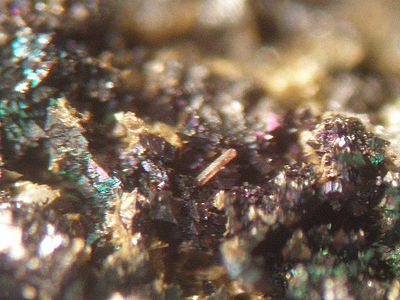Wakefieldit- (La)
| Wakefieldit- (La) | |
|---|---|
| Light brown, prismatic crystal of wakefieldite (La) on hausmannite from the Glücksstern mine, am Gottlob , Friedrichroda , Thuringia (image size: 3 mm) | |
| General and classification | |
| other names |
IMA 1989-035a |
| chemical formula | La [VO 4 ] |
|
Mineral class (and possibly department) |
Phosphates, arsenates, vanadates |
|
System no. to Strunz and to Dana |
8.AD.35 ( 8th edition : VII / A.14) 04 /38/ 11.0 |
| Crystallographic Data | |
| Crystal system | tetragonal |
| Crystal class ; symbol | 4 / mm |
| Space group | I 4 1 / amd (No. 141) |
| Lattice parameters | a = 7.406 Å ; c = 6.504 Å |
| Formula units | Z = 4 |
| Physical Properties | |
| Mohs hardness | 4th |
| Density (g / cm 3 ) | 4.703 |
| Cleavage | not recognizable, but possible after {100} |
| Break ; Tenacity | uneven, brittle |
| colour | light pink to brownish |
| Line color | White |
| transparency | transparent to translucent |
| shine | Diamond luster |
| Crystal optics | |
| Refractive indices |
n ω > 1.9 n ε > 1.9 |
| Birefringence | δ = medium |
| Optical character | uniaxial positive |
| Pleochroism | visible: ε = pale pink and ω = pale pink-yellow |
Wakefieldit- (La) is a very rarely occurring mineral from the mineral class of " phosphates , arsenates and vanadates ". It crystallizes in the tetragonal crystal system with the chemical composition La [VO 4 ] and only develops small, prismatic crystals up to about 0.5 mm in length from light pink to brownish color.
Etymology and history
Wakefieldite- (La) was discovered for the first time in 2001 in some mineral samples from the dump of the disused "Grube Glücksstern" at Gottlob near Friedrichroda in Thuringia together with hausmannite and gottlobite . Analyzed, scientifically described and appropriately named as a lanthanum-dominated relative of wakefieldite- (Ce) (after Deliens and Piret, 1977) and wakefieldite- (Y) (after Hogarth and Miles, 1969), the mineral was named in 2007 by Thomas Witzke , Uwe Kolitsch , Jens M. Warnsloh and Jürgen Göske. It was recognized as an independent mineral by the International Mineralogical Association (IMA) in the same year. However, since there was already an application with an identical name submitted by DG Howard, RW Tschernich and GL Klein, but which was not recognized due to doubts about the analysis result, the application submitted by Witzke et al. submitted, completely independent proposal, the same number IMA1989-035a . Re-analysis by Howard et al. 1995 showed that his material was lanthanum-rich wakefieldite (Ce).
The publication of the research results by Witzke et al. and the recognized name Wakefieldite- (La) followed in December 2008 in the "European Journal of Mineralogy" under the title Wakefieldite- (La), LaVO 4 , a new mineral species from the Glücksstern Mine, Friedrichroda, Thuringia, Germany .
Type material of the mineral is kept in the Mineralogical Collection of the Bergakademie Freiberg (No. 81876).
classification
In the meanwhile outdated, but still in use 8th edition of the mineral classification according to Strunz , the Wakefieldit- (La) belonged to the general section of "Anhydrous phosphates [PO 4 ] 3− , without foreign anions ", where together with Chernovit- (Y) , Pretulit , Wakefieldit- (Ce) , Wakefieldit- (Y) , Xenotim- (Y) and Xenotim- (Yb) the "Xenotime group" with the system no. VII / A.14 .
The systematics of minerals according to Strunz (9th edition) , which has been valid since 2001 and is used by the IMA, belongs to the Wakefieldit- (La) to the division of “phosphates etc. without additional anions; without H 2 O ”and the sub-section“ With only large cations ”, where together with chernovite (Y) , clinobisvanite , dreyerite , pretulite , wakefieldite (Ce), wakefieldite (Y), xenotime (Y) and xenotime - (Yb) also the "Xenotim group" with the system no. 8.AD.35 forms.
The systematics of minerals according to Dana , which is common in the English-speaking world , assigns the wakefieldite- (La) to the division of “anhydrous phosphates etc., with the general formula A + XO 4 ” and there into the sub-division of the “ xenotime group (tetragonal: I. 4 1 / amd ) ”, where it forms the unnamed group 38.4.11 together with xenotime (Y), chernovite (Y), wakefieldite (Y), wakefieldite (Ce), pretulite and xenotime (Yb) .
Crystal structure
Wakefieldite- (La) crystallizes tetragonally in the space group I 4 1 / amd (space group no. 141) with the lattice parameters a = 7.406 Å and c = 6.504 Å and 4 formula units per unit cell . The mineral has a crystal structure of the zirconium type.
Education and Locations
Wakefieldit- (La) is formed in hydrothermal barite - courses and is found in drusen on Hausmannite grew up. Other accompanying minerals include barite and gottlobite .
So far (status: 2010) the mineral could only be detected at its type locality "Grube Glücksstern".
See also
literature
- Thomas Witzke, Uwe Kolitsch, Jens M. Warnsloh, Jürgen Göske: Wakefieldite- (La), LaVO 4 , a new mineral species from the Glücksstern Mine, Friedrichroda, Thuringia, Germany . In: European Journal of Mineralogy . tape 20 , no. 6 , 2008, p. 1135-1140 , doi : 10.1127 / 0935-1221 / 2009 / 0021-1875 .
Web links
Individual evidence
- ↑ Webmineral - Wakefieldit- (La) (English)
- ↑ a b c Thomas Witzke : First descriptions of new minerals in which I am involved. Wakefieldit- (La) at www.strahl.org
- ↑ a b c d e Thomas Witzke : The discovery of Wakefieldit- (La) at www.strahl.org
